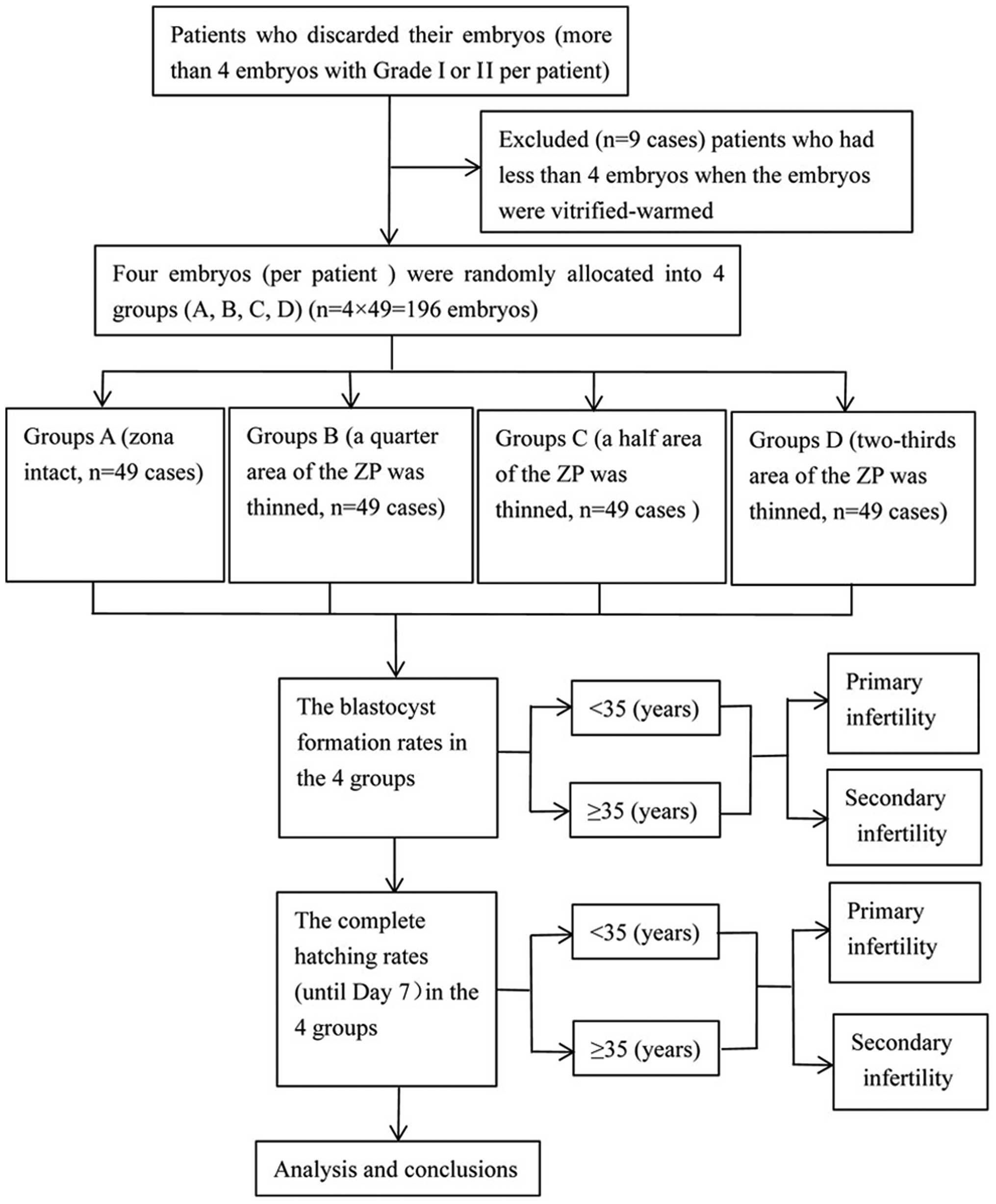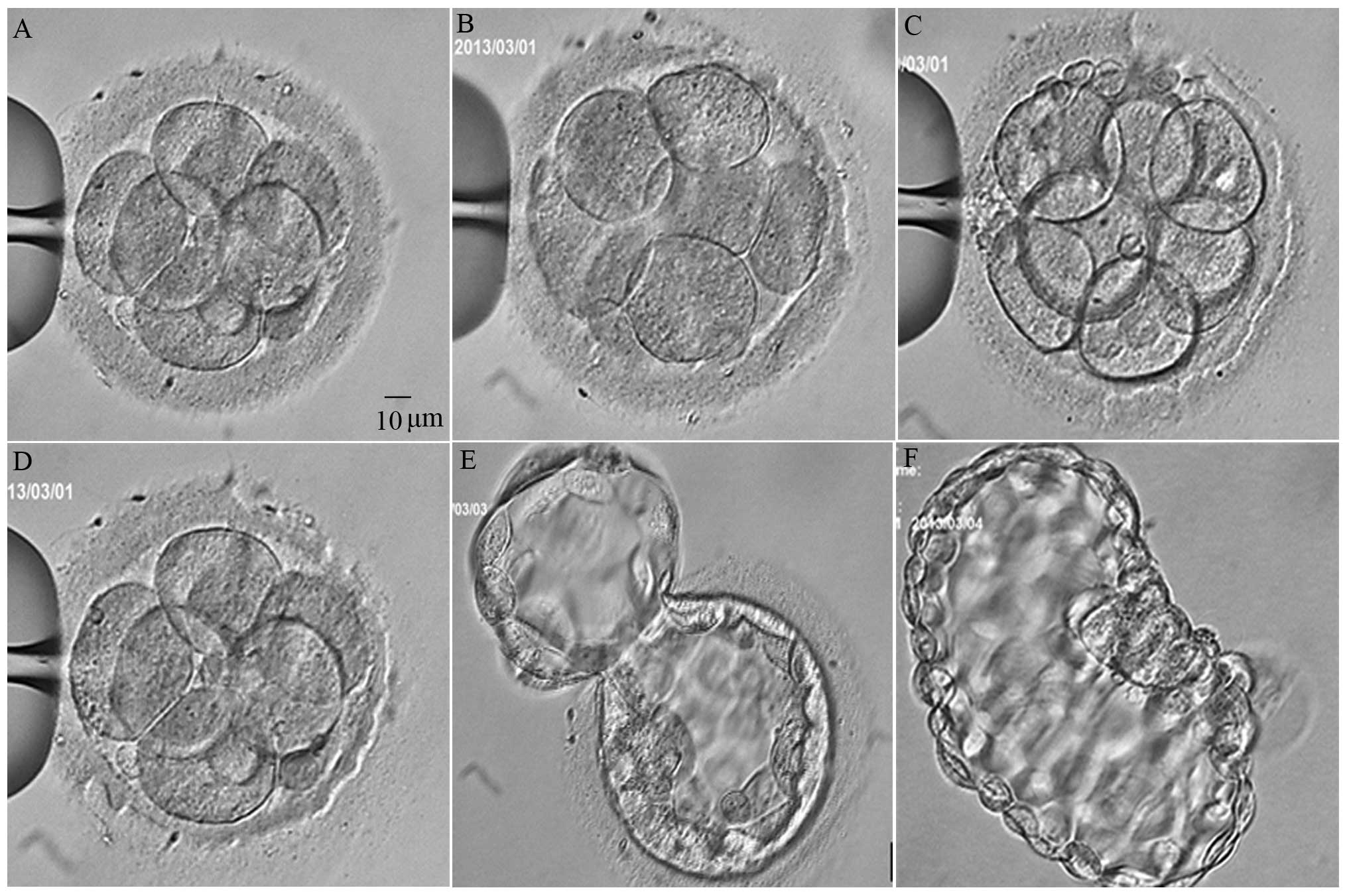|
1
|
Hiraoka K, Hiraoka K, Horiuchi T, Kusuda
T, Okano S, Kinutani M and Kinutani K: Impact of the size of zona
pellucida thinning area on vitrified-warmed cleavage-stage embryo
transfers: a prospective, randomized study. J Assist Reprod Genet.
26:515–521. 2009. View Article : Google Scholar : PubMed/NCBI
|
|
2
|
Andersen AN, Goossens V, Ferraretti AP,
Bhattacharya S, Felberbaum R, de Mouzon J and Nygren KG: European
IVF-monitoring (EIM) Consortium; European Society of Human
Reproduction and Embryology (ESHRE): Assisted reproductive
technology in Europe, 2004: results generated from European
registers by ESHRE. Hum Reprod. 23:756–771. 2008. View Article : Google Scholar : PubMed/NCBI
|
|
3
|
Carroll J, Depypere H and Matthews CD:
Freeze-thaw-induced changes of the zona pellucida explains
decreased rates of fertilization in frozen-thawed mouse oocytes. J
Reprod Fertil. 90:547–553. 1990. View Article : Google Scholar : PubMed/NCBI
|
|
4
|
Hsieh YY, Huang CC, Cheng TC, Chang CC,
Tsai HD and Lee MS: Laser-assisted hatching of embryos is better
than the chemical method for enhancing the pregnancy rate in women
with advanced age. Fertil Steril. 78:179–182. 2002. View Article : Google Scholar : PubMed/NCBI
|
|
5
|
Makrakis E, Angeli I, Agapitou K, Pappas
K, Dafereras A and Pantos K: Laser versus mechanical assisted
hatching: a prospective study of clinical outcomes. Fertil Steril.
86:1596–1600. 2006. View Article : Google Scholar : PubMed/NCBI
|
|
6
|
Primi MP, Senn A, Montag M, Van der Ven H,
Mandelbaum J, Veiga A, Barri P and Germond M: A European
multicentre prospective randomized study to assess the use of
assisted hatching with a diode laser and the benefit of an
immunosuppressive/antibiotic treatment in different patient
populations. Hum Reprod. 19:2325–2333. 2004. View Article : Google Scholar : PubMed/NCBI
|
|
7
|
Ng EH, Naveed F, Lau EY, Yeung WS, Chan
CC, Tang OS and Ho PC: A randomized double-blind controlled study
of the efficacy of laser-assisted hatching on implantation and
pregnancy rates of frozen-thawed embryo transfer at the cleavage
stage. Hum Reprod. 20:979–985. 2005. View Article : Google Scholar : PubMed/NCBI
|
|
8
|
Sifer C, Sellami A, Poncelet C, Kulski P,
Martin-Pont B, Bottero J, Porcher R, Cedrin-Durnerin I, Hugues JN
and Wolf JP: A prospective randomized study to assess the benefit
of partial zona pellucida digestion before frozen-thawed embryo
transfers. Hum Reprod. 21:2384–2389. 2006. View Article : Google Scholar : PubMed/NCBI
|
|
9
|
Petersen CG, Mauri AL, Baruffi RL,
Oliveira JB, Felipe V, Massaro FC and Franco JG Jr: Laser-assisted
hatching of cryopreserved-thawed embryos by thinning one quarter of
the zona. Reprod Biomed Online. 13:668–675. 2006. View Article : Google Scholar : PubMed/NCBI
|
|
10
|
Gabrielsen A, Agerholm I, Toft B, Hald F,
Petersen K, Aagaard J, Feldinger B, Lindenberg S and Fedder J:
Assisted hatching improves implantation rates on
cryopreserved-thawed embryos. A randomized prospective study. Hum
Reprod. 19:2258–2262. 2004. View Article : Google Scholar : PubMed/NCBI
|
|
11
|
Balaban B, Urman B, Yakin K and Isiklar A:
Laser-assisted hatching increases pregnancy and implantation rates
in cryopreserved embryos that were allowed to cleave in vitro after
thawing: a prospective randomized study. Hum Reprod. 21:2136–2140.
2006. View Article : Google Scholar : PubMed/NCBI
|
|
12
|
Ge HS, Zhou W, Zhang W and Lin JJ: Impact
of assisted hatching on fresh and frozen-thawed embryo transfer
cycles: a prospective, randomized study. Reprod Biomed Online.
16:589–596. 2008. View Article : Google Scholar : PubMed/NCBI
|
|
13
|
Valojerdi MR, Eftekhari-Yazdi P, Karimian
L and Ashtiani SK: Effect of laser zona pellucida opening on
clinical outcome of assisted reproduction technology in patients
with advanced female age, recurrent implantation failure, or
frozen-thawed embryos. Fertil Steril. 90:84–91. 2008. View Article : Google Scholar : PubMed/NCBI
|
|
14
|
Martins WP, Rocha IA, Ferriani RA and
Nastri CO: Assisted hatching of human embryos: a systematic review
and meta-analysis of randomized controlled trials. Hum Reprod
Update. 17:438–453. 2011. View Article : Google Scholar : PubMed/NCBI
|
|
15
|
Blake DA, Forsberg AS, Johansson BR and
Wikland M: Laser zona pellucida thinning - an alternative approach
to assisted hatching. Hum Reprod. 16:1959–1964. 2001. View Article : Google Scholar : PubMed/NCBI
|
|
16
|
Mantoudis E, Podsiadly BT, Gorgy A, Venkat
G and Craft IL: A comparison between quarter, partial and total
laser assisted hatching in selected infertility patients. Hum
Reprod. 16:2182–2186. 2001. View Article : Google Scholar : PubMed/NCBI
|
|
17
|
Debrock S, Peeraer K, Spiessens C,
Willemen D, De Loecker P and D'Hooghe TM: The effect of modified
quarter laser-assisted zona thinning on the implantation rate per
embryo in frozen/vitrified-thawed/warmed embryo transfer cycles: a
prospective randomized controlled trial. Hum Reprod. 26:1997–2007.
2011. View Article : Google Scholar : PubMed/NCBI
|
|
18
|
Puissant F, Van Rysselberge M, Barlow P,
Deweze J and Leroy F: Embryo scoring as a prognostic tool in IVF
treatment. Hum Reprod. 2:705–708. 1987.PubMed/NCBI
|
|
19
|
Cooper TG, Noonan E, von Eckardstein S,
Auger J, Baker HW, Behre HM, Haugen TB, Kruger T, Wang C, Mbizvo
MT, et al: World Health Organization reference values for human
semen characteristics. Hum Reprod Update. 16:231–245. 2010.
View Article : Google Scholar : PubMed/NCBI
|
|
20
|
Kowalik A, Palermo GD, Barmat L, Veeck L,
Rimarachin J and Rosenwaks Z: Comparison of clinical outcome after
cryopreservation of embryos obtained from intracytoplasmic sperm
injection and in-vitro fertilization. Hum Reprod. 13:2848–2851.
1998. View Article : Google Scholar : PubMed/NCBI
|
|
21
|
Aytoz A, Van den Abbeel E, Bonduelle M,
Camus M, Joris H, Van Steirteghem A and Devroey P: Obstetric
outcome of pregnancies after the transfer of cryopreserved and
fresh embryos obtained by conventional in-vitro fertilization and
intracytoplasmic sperm injection. Hum Reprod. 14:2619–2624. 1999.
View Article : Google Scholar : PubMed/NCBI
|
|
22
|
Hu Y, Maxson WS, Hoffman DI, Ory SJ and
Eager S: A comparison of post-thaw results between cryopreserved
embryos derived from intracytoplasmic sperm injection and those
from conventional IVF. Fertil Steril. 72:1045–1048. 1999.
View Article : Google Scholar : PubMed/NCBI
|
|
23
|
Hiraoka K, Fuchiwaki M, Hiraoka K,
Horiuchi T, Murakami T, Kinutani M and Kinutani K: Zona pellucida
removal and vitrified blastocyst transfer outcome: a preliminary
study. Reprod Biomed Online. 15:68–75. 2007. View Article : Google Scholar : PubMed/NCBI
|
|
24
|
Edwards RG: Clinical approaches to
increasing uterine receptivity during human implantation. Hum
Reprod. 10(Suppl 2): 60–66. 1995. View Article : Google Scholar : PubMed/NCBI
|
|
25
|
Huisman GJ, Fauser BC, Eijkemans MJ and
Pieters MH: Implantation rates after in vitro fertilization and
transfer of a maximum of two embryos that have undergone three to
five days of culture. Fertil Steril. 73:117–122. 2000. View Article : Google Scholar : PubMed/NCBI
|
|
26
|
Kutlu P, Atvar O and Vanlioglu OF: Laser
assisted zona thinning technique has no beneficial effect on the
ART outcomes of two different maternal age groups. J Assist Reprod
Genet. 27:457–461. 2010. View Article : Google Scholar : PubMed/NCBI
|
|
27
|
Cohen J: Assisted hatching of human
embryos. J In Vitro Fert Embryo Transf. 8:179–190. 1991. View Article : Google Scholar : PubMed/NCBI
|
|
28
|
Malter HE and Cohen J: Blastocyst
formation and hatching in vitro following zona drilling of mouse
and human embryos. Gamete Res. 24:67–80. 1989. View Article : Google Scholar : PubMed/NCBI
|
|
29
|
Hershlag A and Feng HL: Effect of
prefreeze assisted hatching on postthaw survival of mouse embryos.
Fertil Steril. 84:1752–1754. 2005. View Article : Google Scholar : PubMed/NCBI
|
|
30
|
Debrock S, Spiessens C, Peeraer K, De
Loecker P, Willemen D and D'Hooghe TM: Higher implantation rate
using modified quarter laser-assisted zona thinning in repeated
implantation failure. Gynecol Obstet Invest. 67:127–33. 2009.
View Article : Google Scholar : PubMed/NCBI
|
|
31
|
Edi-Osagie EC, Hooper L, McGinlay P and
Seif MW: Effect(s) of assisted hatching on assisted conception (IVF
& ICSI). Cochrane Database Syst Rev (4): CD001894. 2003.
View Article : Google Scholar
|











